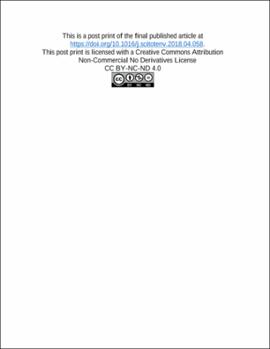| dc.contributor.author | Koch, Jennifer | |
| dc.contributor.author | Wimmer, Florian | |
| dc.contributor.author | Schaldach, Rüdiger | |
| dc.date.accessioned | 2018-12-05T18:01:55Z | |
| dc.date.available | 2018-12-05T18:01:55Z | |
| dc.date.issued | 2018 | |
| dc.identifier.citation | Koch, J., Wimmer, F., & Schaldach, R. (2018). Analyzing the relationship between urbanization, food supply and demand, and irrigation requirements in Jordan. Science of The Total Environment, 636, 1500-1509. https://doi.org/10.1016/j.scitotenv.2018.04.058 | en_US |
| dc.identifier.uri | https://hdl.handle.net/11244/316274 | |
| dc.description.abstract | The landscape surrounding urban areas is often used as farmland. With the observed expansion of urban areas over the last decades and a projected continuation of this trend, our objective was to analyze how urbanization affects food supply and demand in The Hashemite Kingdom of Jordan. We used a chain of simulation models covering components of the atmosphere (climate simulations), biosphere (crop yield calculations), and anthroposphere (simulations of urban expansion and land-use change) to calculate the effect of farmland displacement on land and water resources (hydrosphere). Our simulations show that the displacement of farmland itself has hardly any effect on cropland demand, crop yields, or irrigation water requirements. These results indicate that Jordan has sufficient productive areas available to buffer effects of urban expansion on food production for the next decades. However, this picture changes dramatically once we include changes in socioeconomy and climate in our simulations. The isolated effect of climate change results in an expected increase in irrigation water requirements of 19 MCM by 2025 and 64 MCM by 2050. It furthermore leads to an increase in cropland area of 147 km2 by 2025 and 265 km2 by 2050. While the combined analysis of urban expansion, climate change, and socioeconomic change makes optimistic assumptions on the increase in crop yields by 2050, the results still indicate a pronounced effect on cropland demands (2700 km2) and a steep increase in irrigation water requirements (439 MCM). Our simulation results highlight the importance of high resolution, spatially explicit projections of future land changes as well as the importance of spatiotemporal scenario studies at the regional level to help improving water planning strategies. | en_US |
| dc.description.sponsorship | The research presented in this manuscript was funded by the German Federal Ministry of Education and Research [contract 01LW0502]. We would like to thank our colleagues from IMK-559 IFU for providing the climate data without which this study would not have been possible. The authors thank the anonymous reviewers for their constructive comments that helped improve the quality of this manuscript. | en_US |
| dc.language | en_US | en_US |
| dc.rights | Attribution-NonCommercial-NoDerivatives 4.0 International | * |
| dc.rights.uri | https://creativecommons.org/licenses/by-nc-nd/4.0/ | * |
| dc.subject | land systems | en_US |
| dc.subject | climate change | en_US |
| dc.subject | food supply and demand | en_US |
| dc.subject | scenario analysis | en_US |
| dc.subject | Middle East | en_US |
| dc.subject | urbanization | en_US |
| dc.subject | Geography. | en_US |
| dc.subject | Urban and Regional Planning. | en_US |
| dc.title | Analyzing the relationship between urbanization, food supply and demand, and irrigation requirements in Jordan | en_US |
| dc.type | Article | en_US |
| dc.description.peerreview | Yes | en_US |
| dc.description.peerreviewnotes | This journal operates a single blind review process. All contributions will be initially assessed by the editor for suitability for the journal. Papers deemed suitable are then typically sent to a minimum of two independent expert reviewers to assess the scientific quality of the paper. The Editor is responsible for the final decision regarding acceptance or rejection of articles. The Editor's decision is final. | en_US |
| dc.identifier.doi | 10.1016/j.scitotenv.2018.04.058 | en_US |
| ou.group | College of Atmospheric and Geographic Sciences::Department of Geography and Environmental Sustainability | en_US |

